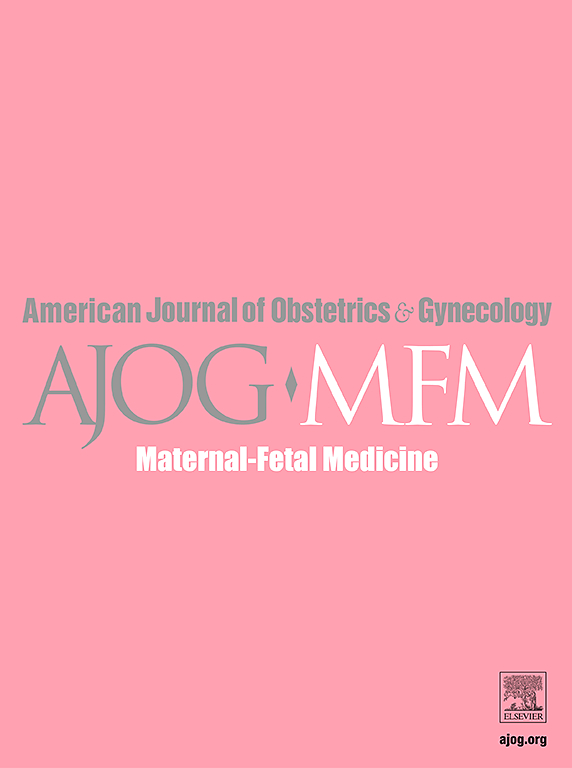Propranolol to decrease time to delivery: a meta-analysis of randomized controlled trials
IF 3.1
2区 医学
Q1 OBSTETRICS & GYNECOLOGY
American Journal of Obstetrics & Gynecology Mfm
Pub Date : 2025-05-23
DOI:10.1016/j.ajogmf.2025.101705
引用次数: 0
Abstract
OBJECTIVE
This study aimed to assess the effect of propranolol on the time to delivery among patients undergoing induction or augmentation of labor.
DATA SOURCES
PubMed, Scopus, Cochrane Library, ClinicalTrials.gov, and CINAHL (EBSCO) databases were searched from inception to December 2023.
STUDY ELIGIBILITY CRITERIA
Randomized controlled trials that examined the effect of propranolol on the time to delivery among patients undergoing induction or augmentation of labor were included. Randomized controlled trials that included stillbirth before randomization, nonrandomized trials, observational, cohort, case-control, or studies in which the control group included an intervention other than standard care were excluded.
METHODS
The primary outcome was time to delivery after the administration of propranolol among patients undergoing induction or augmentation of labor. The summary measures were reported as summary mean difference or relative risk with 95% confidence interval.
RESULTS
A total of 5 randomized controlled trials involving 660 patients were included in this meta-analysis. 1 study investigated the effect of propranolol compared with that of placebo among patients undergoing induction of labor and did not demonstrate a significant decrease in the time to delivery (828±324 minutes in the propranolol group vs 858±318 minutes in the placebo group; P=.48). In addition, 4 studies investigated the effect of propranolol among patients undergoing augmentation of labor and showed no significant decrease in the time to delivery (mean difference, −2.98 minutes [95% confidence interval, −21.6 to 15.6]). Our pooled analysis demonstrated that the use of propranolol in the induction and augmentation of labor was not associated with a decrease in the time to delivery from the administration of propranolol compared with that of placebo (mean difference, −4.33 minutes [95% confidence interval, −22.48 to 13.83]). The meta-analysis found no increased risk of postpartum hemorrhage, blood transfusion, cesarean delivery rate, or neonatal intensive care unit admission with the use of propranolol during labor.
CONCLUSION
The use of propranolol during induction and augmentation of labor did not significantly decrease the time to delivery.
心得安减少给药时间:随机对照试验的荟萃分析。
目的:评价普萘洛尔对引产或助产患者分娩时间的影响。数据来源:PubMed, Scopus, Cochrane Library, ClinicalTrials.gov和CINAHL (EBSCO)从成立到2023年12月检索。研究资格标准:纳入随机对照试验(rct),检查普萘洛尔对引产或助产患者分娩时间的影响。包括随机化前死胎、非随机试验、观察性试验、队列、病例对照或对照组包括标准治疗以外干预措施的研究的随机对照试验均被排除。研究评价和综合方法:主要观察指标为引产或助产患者服用心得安后的分娩时间。总结测量结果以总平均差(MD)或相对风险(95%可信区间(CI))报告。结果:本meta分析纳入了5项随机对照试验,共660例患者。一项研究调查了心得安与安慰剂在引产(IOL)患者中的作用,并没有显示分娩时间的显著减少(828分钟±324 vs 858分钟±318,p=0.48)。四项研究调查了普萘洛尔对增加产程的患者的影响,结果显示分娩时间没有显著减少(MD, -2.98分钟,95% CI -21.6 ~ 15.6)。我们的汇总分析表明,与安慰剂相比,使用心得安进行人工智能和增强与服用心得安到分娩时间的减少无关(平均差异为-4.33分钟,95% CI为-22.48至13.83)。荟萃分析发现,在分娩过程中使用心得安不会增加PPH、输血、剖宫产率或新生儿重症监护病房入院的风险。结论:在引产和助产过程中使用心得安对缩短分娩时间无显著影响。
本文章由计算机程序翻译,如有差异,请以英文原文为准。
求助全文
约1分钟内获得全文
求助全文
来源期刊

American Journal of Obstetrics & Gynecology Mfm
Medicine-Medicine (all)
CiteScore
7.40
自引率
3.20%
发文量
254
审稿时长
40 days
期刊介绍:
The American Journal of Obstetrics and Gynecology (AJOG) is a highly esteemed publication with two companion titles. One of these is the American Journal of Obstetrics and Gynecology Maternal-Fetal Medicine (AJOG MFM), which is dedicated to the latest research in the field of maternal-fetal medicine, specifically concerning high-risk pregnancies. The journal encompasses a wide range of topics, including:
Maternal Complications: It addresses significant studies that have the potential to change clinical practice regarding complications faced by pregnant women.
Fetal Complications: The journal covers prenatal diagnosis, ultrasound, and genetic issues related to the fetus, providing insights into the management and care of fetal health.
Prenatal Care: It discusses the best practices in prenatal care to ensure the health and well-being of both the mother and the unborn child.
Intrapartum Care: It provides guidance on the care provided during the childbirth process, which is critical for the safety of both mother and baby.
Postpartum Issues: The journal also tackles issues that arise after childbirth, focusing on the postpartum period and its implications for maternal health. AJOG MFM serves as a reliable forum for peer-reviewed research, with a preference for randomized trials and meta-analyses. The goal is to equip researchers and clinicians with the most current information and evidence-based strategies to effectively manage high-risk pregnancies and to provide the best possible care for mothers and their unborn children.
 求助内容:
求助内容: 应助结果提醒方式:
应助结果提醒方式:


